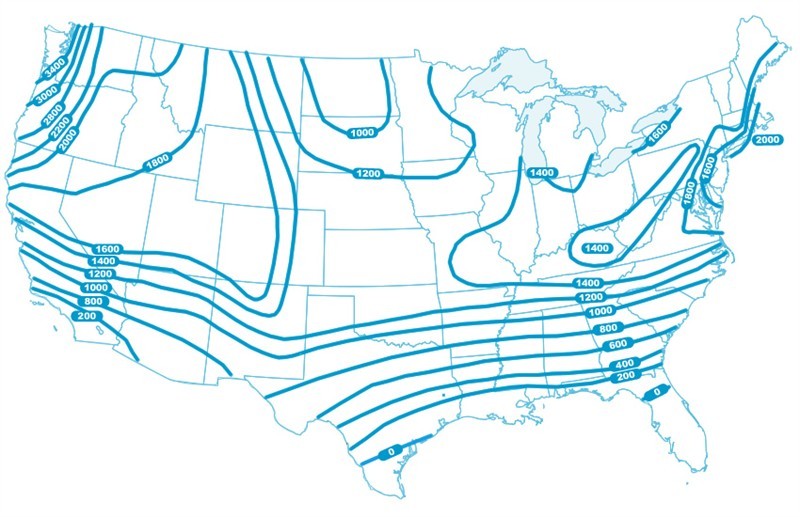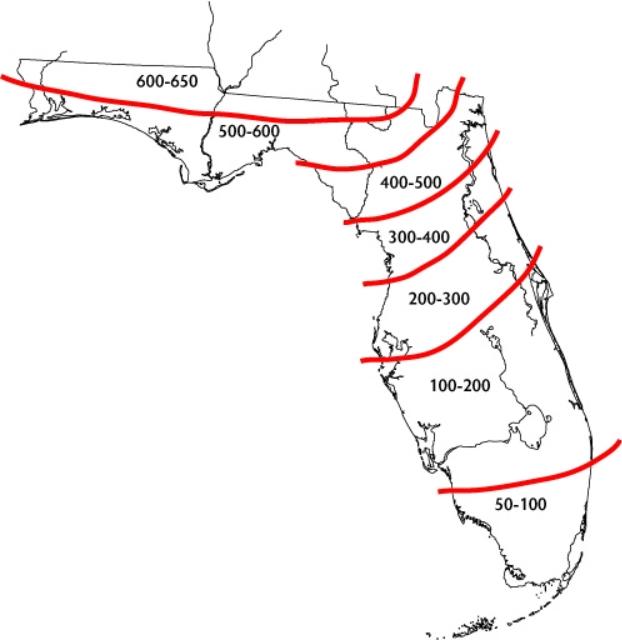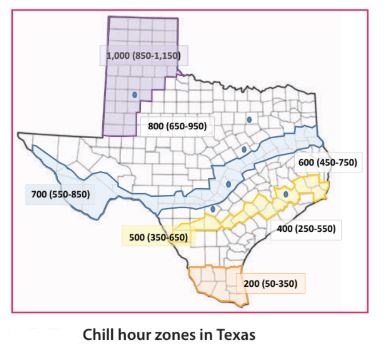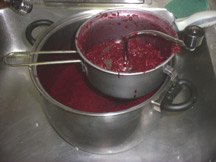
Looking for Best Apple Varieties to Grow in 2025? Scroll down this page and follow the links. And if you bring home some fruit or vegetables and want to can, freeze, make jam, salsa or pickles, see this page for simple, reliable, illustrated canning, freezing or preserving directions. There are plenty of other related resources, click on the resources dropdown above. If you are having a hard time finding canning lids, I've used these, and they're a great price & ship in 2 days.
If you have questions or feedback, please let me know! There are affiliate links on this page. Read our disclosure policy to learn more.
Notes for August 2025: Spring is here! Strawberry season is here. It started in February in Florida, Texas, southern California and a few other areas of the Deep South; then March along the Gulf coast, April in the Deep South and west coast, May through much of the country, and June in northern areas. Blueberries are next, about a month later. Of course, cool weather crops, like Rhubarb, asparagus and greens should be available almost everywhere. Check your area's crop calendar (see this page) and call your local farms for seasonal updates.
You may also be interested in finding a local:
- Children's Consignment Sale happening now; save money on children's clothes, toys, books, etc, find a local children's consignment sale, also often held by churches in the Spring and Fall, click here!
- Fun factory tours - usually free, fun and educational, find them in every state here!
- Road trip or a Camping trip - Find free and low-cost, but fun, interesting places to visit and things to do and see!
Are carpenter bees boring holes into your house, shed or barn? There is a simple non-toxic solution!
NEW! Start your own tomato, pepper, squash and other vegetable plants from seed - It's easy and
costs about 50 cents per plant.
Also see our Master list of tomato varieties,
with descriptions, details and links to ordering the seeds.
We also have home canning, preserving, drying and freezing directions. You can access recipes and other resources from the drop down menus at the top of the page or the site search. If you have any questions or suggestions, feel free to write me! It is easy to make your own ice cream, even gelato, or low fat or low sugar ice cream - see this page. Also note, there are many copycat website listing U-pick farms now. They have all copied their information from here and usually do not ever update. Since 2002, I've been updating the information every day but Christmas; so if you see anything wrong or outdated, please write me!
Apples: Best Apple Varieties to Grow
Choosing the Best Variety of Apple to Grow in Your Area
Which to grow in your area and why!
This page helps you find the right variety of apple to grow in your area. For detailed descriptions of many apple varieties that you can pick or buy at the grocery store (or grow), see this page! Also, see our pages on tips for picking apples at a farm, easy illustrated directions to make applesauce, apple butter, apple jelly and apple pie; and our list of apple festivals!
Choosing the right variety of apple for your yard
Ultimately, best best variety is the one you like to eat best, but there are some other considerations:
-
Know your area's Chilling h
 ours:
Apples, like all stone fruit, require a specific duration of
cold below 40 F in order to set a good crop. Specifically,
chilling hours are the number of hours below 45F accumulated by
the tree during the winter to overcome dormancy. Knowing the
typical chill hour accumulation for your area should be one of
the primary criteria you use in choosing varieties that are
suitable to grow there. This map, from the University of
Maryland's research, gives you a good idea for your area, to
match up against the requirements of each variety of apple that
you like. Most apple varieties have a chill requirement of
about 1,000 hours or more, which is readily achieved in the
temperate apple-growing regions of the USA (which, you can see
from the map, does NOT include Florida, south Georgia and much
of the Gulf Coast areas) But you need to check your specific
state and area. The northern half of
Alabama, for example, can grow apples (see this page).
Apples do grow well in most areas of South America, South
Africa, Australia, New Zealand, and Europe. Sorry Florida, apple
trees will grow there, but rarely produce fruit.
ours:
Apples, like all stone fruit, require a specific duration of
cold below 40 F in order to set a good crop. Specifically,
chilling hours are the number of hours below 45F accumulated by
the tree during the winter to overcome dormancy. Knowing the
typical chill hour accumulation for your area should be one of
the primary criteria you use in choosing varieties that are
suitable to grow there. This map, from the University of
Maryland's research, gives you a good idea for your area, to
match up against the requirements of each variety of apple that
you like. Most apple varieties have a chill requirement of
about 1,000 hours or more, which is readily achieved in the
temperate apple-growing regions of the USA (which, you can see
from the map, does NOT include Florida, south Georgia and much
of the Gulf Coast areas) But you need to check your specific
state and area. The northern half of
Alabama, for example, can grow apples (see this page).
Apples do grow well in most areas of South America, South
Africa, Australia, New Zealand, and Europe. Sorry Florida, apple
trees will grow there, but rarely produce fruit.
Some exceptions: Anna, a Golden Delicious style apple, and Ein Shemer, a yellow/green variety, developed in Israel, both tolerate climates with only 300-400 chilling hours. Dorsett Golden, which was found in the Bahamas, needs less than 100 hours.
You also should check your area's planmt hardiness zone on the US plant hardiness zone map. - Select varieties that have a chilling requirement at least 20% less than local averages.
- The chilling hours need to match your area: If you choose a low chill variety in a cold area, that will result in trees flowering too early and being damaged by late frosts. Conversely, choosing a high chill variety in a warm area will result in little or no fruit production.
- Early ripening varieties tend to be best in areas with hot summers, like the Deep South, and late ripening varieties are best in areas with cooler summers, like the northern US and Canada..
- Local terrain can affect the chilling hours actually received. For example, open slopes may receive more chilling hours than sheltered areas next to the south side of warm buildings.
- Freezes, late frosts and winter cold: Too much cold, or cold at the wrong time can be equally harmful; see this page.
- Disease resistance - some varieties have been found to be more resistant to bugs, fungus and bacteria attacks.
- Heirloom, like Orange Pippin; or modern variety, like Honeycrisp? It's just your preference; there are no "GMO apple" varieties.
- Climate change? at least for now, there is a trend towards shorter, winters and longer hotter summers, l so keep that in mind when choosing varieties
- How to find out which variety does best in your area? Ask the nursery. Usually, the online nurseries, like Raintree, put it in the description for each apple tree.
Finally, if you have an apple tree and want to know what variety it is, see this page.
Websites for Apple Variety Descriptions:
Apple Trees for Northern Climates (Saint Lawrence Nursery - NY)
The best list of apples, both modern and heirloom, for northern states,
including Maine, New Hampshire, Vermont, upstate New York, Minnesota, Wisconsin,
North Dakota, South Dakota, Wisconsin, and Alaska. It is an especially good site
for finding hardiness information.
Big Horse Creek Farm - Master Variety List
Descriptions of about 300 varieties from this nursery located in North Carolina.
This is an excellent source for descriptions of apples suitable for the southern
or Appalachian regions.
Apple Varieties for Home Production
A huge alphabetical list of varieties suitable for various regions from
NaturalHub.com.
FairShare Recipe Exchange - Apple Varieties
Another alphabetical list. This one emphasizes the culinary uses of the
varieties listed.
Apple Source (Descriptions of the apple varieties they sell)
Want to try some of the apples you've picked for your orchard? This site not
only offers descriptions, but they also sell and ship more than 80 kinds of
apples!
Tree of Antiquity
Brief descriptions of hundreds of varieties as well as information on
disease-resistant varieties and a comparison (complete with pictures) of popular
apples.
The many apple associations listed on this page have more facts and resources
Apples for making apple cider
The following varieties are consider ideal for apple cider. They are all juicy, sweet and cook readily.:
- Empire
- Gala
- Golden Delicious
- Golden Russet
- Goldrush
- Jonathan
- Jonagold
- McIntosh
- Northern Spy
Recommended Apple Varieties for 40 States :
If the link for your state does not tell you enough about apples recommended for your region, use the sites above to find out more about the varieties you are considering including in your orchard.
Alabama
Apple Varieties in Alabama (Alabama Cooperative Extension)
Alaska
Vegetable and Fruit Varieties for Interior Alaska (U. of Alaska - Fairbanks)
Recommended Varieties for South Central Alaska (UAF)
Alaska Apples
Arizona
Fruit Trees: Planting and Varieties (University of Arizona)
Fruit Trees: Introduction and Plant Climate Zones (University of Arizona)
Arkansas
Apple Production in the Home Garden (U. of Arkansas)
California
Growing
apples in California
(University of California - UC Davis)
Colorado
Fruit Fetish (Colorado State University)
Delaware
Apple
disease management in Delaware
Florida
Low Chill Apple Cultivars for North and North Central Florida (IFAS Extension)
Georgia
Home Garden Apples (U. of Georgia)
Idaho
Apple Cultivars for East Idaho (U. of Idaho Extension)
Illinois
Apples and More (U. of Illinois Extension)
Fruits and Nuts that Do Well in the Chicago Area (Bob Kurle's Fruit and Nut
List)
Indiana
Apple Cultivars
(apple varieties) for Indiana (Purdue U.)
Iowa
Apple Varieties and Their Uses (Iowa State U.)
Suggested Apple Varieties for Home Gardens in Iowa (Iowa State U.)
Kansas
Fruit and Nut Cultivars (KSU Extension)
Louisiana
The Louisiana Home Orchard (LSU Ag Center)
Maine
Apples Grown by Hillside Orchard (Manchester, Maine)
Apple Varieties (Ricker Hill Orchards - Turner, Maine)
Maryland
Apple Varieties in Maryland (Maryland Apple Promotion Board)
Massachusetts
100 Varieties (and that is only counting apples) (U. of Massachusetts Cold
Spring Orchard)
Apples and Crab Apples (U. of Mass.)
Michigan
Apple Scion/Rootstock Selection and Planning for Michigan (MSU)
Minnesota
Growing apples in the home garden
Growing Apples and Pears in Minnesota Gardens (U. of Minn.)
Apples for Minnesota and Their Culinary Uses (U. of M.)
Commercial Fruit Production in Minnesota (U of M)
Missouri
Apple Cultivars and their Uses (U. of Missouri)
Missouri Apple History
Nebraska
Fruit Tree Cultivars for Nebraska (U. Nebraska- Lincoln)
New Hampshire
Dwarf Apple Trees for the Home Garden (University of New Hampshire)
Growing Fruit Trees (UNH)
New Mexico
Fruit Species and Varieties for the Home Orchard (New Mexico State University)
New York
New York Apple Varieties
and information
Apple Varieties Grown in NY State (Cornell Univ)
New York Apple Growing Information and Guidance
North Carolina
Producing Tree Fruit for Home Use (NCSU)
Apple Varieties and Descriptions (Big Horse Creek Farm, North Carolina)
North Dakota
Fruit Tree Culture and Varieties in North Dakota (NDSU)
Oklahoma
Apple and Peach varieties for Oklahoma (Oklahoma Cooperative Extension)
Ohio
Apples: A Guide to Selection and Growing in Home Orchard (Ohio State Univ.)
Oregon
Growing Fruits and Nuts in the Home Orchard (Oregon State U.)
Pennsylvania
Apple cultivars (varieties)
Tree Fruit Production Guide (Penn. State U.)
Heirloom Mid-Atlantic Varieties (Pennsylvania)
South Carolina
Home and Garden Information Center - Apple (South Carolina - Clemson U.)
South Dakota
Fruit Cultivars for South Dakota (South Dakota Cooperative Extension Service)
Tennessee
Fruits and nuts for the TN home orchard (U. of Tennessee)
Texas
Home Fruit Production - Apples (Texas State U.)
Apple Varieties (Texas A. & M.)
Utah
Apples (Utah State U. Extension)
Vermont
Vermont Apple Varieties (Vermont Apple Board)
Virginia
Growing Apples in Virginia (VT Virginia Cooperative Extension)
Tree Fruit in the Home Garden (Virginia Tech)
Vintage Virginia Apples
Washington
Growing Tree Fruit at Home in Eastern Washington (WSU)
Apples in Washington State (WSU)
Apple Research/Variety Trials (WSU)
Backyard Apple Production (WSU)
Wisconsin
Apple Cultivars for Wisconsin (U. or Wisc.)
Apples of Wisconsin (Dane Co. Conservation League)
Canning Books, Supplies and Accessories
These are my favorite essential canning tools, books and supplies. I've been using many of these for over 50 years of canning! The ones below on this page are just the sampling of. my preferred tools. but you can find much more detailed and extensive selections on the pages that are linked below.
- Strainers, pit removers, seed-skin-stem removers, jelly strainers, etc. All types, makes and prices (from $19 to $350)
- Selecting a KitchenAid mixer and attachments for home canning
- Vacuum Foodsealers for freezing, dried foods, and refrigerated foods - the FoodSaver line
- Cherry pitters reviews, prices and ordering
- Steam Juicers
- Food dehydrators - easy and fast to dry your own fruits, veggies, sun-dried tomatoes, etc.
The All New Ball Book Of Canning And Preserving: Over 350 of the Best Canned, Jammed, Pickled, and Preserved Recipes Paperback
This is THE book on canning! My grandmother used this book when I was a child.; It tells you in simple instructions how to can almost anything; complete with recipes for jam, jellies, pickles, sauces, canning vegetables, meats, etc.
If it can be canned, this book likely tells you how! Click on the link below for more information and / or to buy (no obligation to buy)The New Ball Blue Book of Canning and Preserving
Canning and Preserving for Dummies by Karen Ward
This is another popular canning book. Click here for more information, reviews, prices for Canning and Preserving For Dummies
Of course, you do not need to buy ANY canning book as I have about 500 canning, freezing, dehydrating and more recipes all online for free, just see Easy Home Canning Directions.
Home Canning Kits
See here for related tools, equipment, supplies on Amazon See here for related tools, equipment, supplies on Amazon
I have several canners, and my favorite is the stainless steel one at right. It is easy to clean and seems like it will last forever. Mine is 10 years old and looks like new.
The black ones are the same type of standard canner that my grandmother used to make everything from applesauce to jams and jellies to tomato and spaghetti sauce.
This complete kit includes everything you need and lasts for years: the canner, jar rack, Jar grabber tongs, lid lifting wand, a plastic funnel, labels, bubble freer, It's much cheaper than buying the items separately. It's only missing the bible of canning, the Ball Blue Book.
You will never need anything else except jars & lids (and the jars are reusable)!
The complete list of canners is on these pages:
- Water bath canners - Good for acidic foods, like applesauce, pickles, salsa, jams, jellies, most fruits
- Pressure canners - needed for low and non-acidic foods, like canned vegetables (corn, green beans, etc), and meats
- Canners for glass top stoves if you have a glass or ceramic stove
- Canners for induction stovetops
Pressure Canners
If you plan on canning non-acidic foods and low acid foods that are not pickled - this means: meats, seafood, soups, green beans corn, most vegetables, etc., then you ABSOLUTELY must use a Pressure Canner.
Of course, you can use a pressure canner as a water bath canner as well - just don't seal it up, so it does not pressurize. This means a Pressure Canner is a 2-in-1 device. With it, you can can almost ANYTHING.
There are also other supplies, accessories, tools and more canners, of different styles, makes and prices, click here!
Basic Canning Accessories
From left to right:
- Jar lifting tongs to pick up hot jars
- Lid lifter - to remove lids from the pot of boiling water (sterilizing )
- Lids- disposable - you may only use them once
- Ring - holds the lids on the jar until after the jars cool - then you remove them, save them and reuse them
- Canning Jar funnel - to fill the jars
Strainers
These are very useful for making sauces like applesauce, tomato sauce, spaghetti sauce, jellies, etc. Below are my favorites. The complete list is on these pages:
- Strainers, pit removers, seed-skin-stem removers, jelly strainers, etc. All types, makes and prices (from $19 to $350)
- Selecting a KitchenAid mixer and attachments for home canning
Inexpensive Old School Strainers: hand cranked Foley Food Mills
- The hand-cranked Foley food mill (see this page or clock the ad box) has been used for well over 100 years in homes all over America (and variants around the world). It is effective and inexpensive, and ideal for small batches. However, if you need to make many quarts, you will sure end up with tunnel carpel syndrome or some other repetitive strain injury.
Norpro 1951 Manual Food Strainer and other brand stariners, with optional motors; (almost identical to Victorio V250, Villaware and Roma models, all discontinued)
This is The next step up from the Foley food mill. First, it's far more ergonomic, and its handle is easier to use. Next, it works in continuous mode rather than batch mode. So you can do much larger volumes easily. Finally, It has an optional motor, so you can. remove the manual labor. It also offers many different size strainers to use for different types of berries, vegetables and fruit.
See the seller's website for more information, features, pricing and user reviews!
- A Johnny, Weston or Oxo strainer (about $60 - $100, see further down the page) or
- This trainer is. simply a more upscale and improved version of the one above.
- See this page for more information, reviews, descriptions of other strainers and supplies or to order!
KitchenAid - Best Large Volume Strainers
If you're going to do large volumes of fruit or vegetables , or do it year after year, then. you really should think about getting a higher end kitchen. utility device. Kitchen aids are the cream of the crop. Once you buy one of these, you keep at the rest of your life and it gets handed down to the next generation. . My sister is using one she inherited from my mother 25 years ago, who got it in the 1940s as a wedding gift. So, although the initial cost is high, they literally last for many lifetime. So the cost on an annual basis is pretty trivial, especially when you consider the cost of therapy and treatment for. the repetitive strain injuries you will get from manual cranking day after day. Add to that of course the cost of therapy for the emotional injuries you'll get from going insane, standing there hand cranking something for hours.
KitchenAid's with a sieve/grinder (with the attachments, costs about $400, but it lasts a lifetime and is fast and easy to use - I can make 100 quart jars of applesauce per day with one of these).
FREE Illustrated Canning, Freezing, Jam Instructions and Recipes
Don't spend money on books. that you don't need to. Almost everything you can find in some book sold online or in a store is on my website here for free. Start with theEasy Home Canning Directions below. That is a master list of canning directions which are all based upon the Ball Bblue book, the National Center for Home Food Preservation and other reputable lab tested recipes. Almost every recipe I present in addition to being lab tested com. is in a step by step format with photos for each step and complete. explanations. that tell you how to do it, where to get the supplies and pretty much everything you need to know. In addition, there almost always in a PDF format so you can print them out and use them while you cook.
[ Easy Home Canning Directions]
[FAQs - Answers to common questions and problems]
[Recommended books about home canning, jam making, drying and preserving!]
Looking for canning equipment and supplies?
Water bath canner with a jar rack
Pressure canners for gas, electric and induction stoves: Presto 23Qt or T-fal 22Qt
Canning scoop (this one is PERFECT)
Ball Blue book (most recent version)
Jars: 8oz canning jars for jams
Find Other types of farms:
Farm markets and roadside stands
Road trips and camping resources
Local Honey, apiaries, beekeepers
Consumer fraud and scams information
Home canning supplies at the best prices on the internet!
Maple Syrup Farms, sugarworks, maple syrup festivals
Environmental information and resources
Farms For Your Event for birthday parties, weddings, receptions, business meetings, retreats, etc.
Festivals - local fruit and vegetable festivals
Get the
most recent version of
the Ball Blue Book
With this Presto 23 quart pressure canner and pressure cooker, you can "can" everything, fruits, vegetables, jams, jellies, salsa, applesauce, pickles, even meats, soups, stews. Model 01781

You can make jams, jellies, can fruit, applesauce, salsa and pickles with water bath canners, like this Granite Ware 12-Piece Canner Kit, Jar Rack, Blancher, Colander and 5 piece Canning Tool Set




